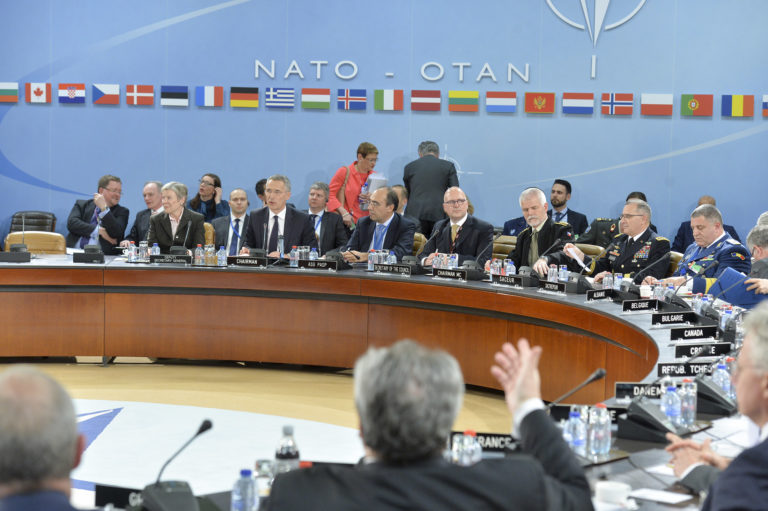Counting Dollars or Measuring Value: Average Refugee Intake
NATO: Counting Dollars or Measuring Value Series

Conflict and instability to Europe’s south – in North Africa and in Syria – has generated population movements into Europe with which our allies have struggled. Projecting stability in this region has increasingly become a priority for the Alliance, particularly since the outbreak of the Syrian Civil War and the onset of the refugee crisis.[1] NATO has launched or adapted maritime security exercises and missions in the Mediterranean, including Operation Sea Guardian, which supports the European Union’s Operation Sophia.[2] Operation Sophia has primarily dealt with managing the illegal flows of refugees and combatting human trafficking through the Mediterranean. Yet, Europe remains—on average—the bearer of the world’s largest refugee burden as classified by the United Nations High Commissioner for Refugees.[3] Some NATO members are bearing a particularly significant burden from the refugee crisis. Managing the crisis is a significant security investment for them and Europe as a whole.
This metric examines the number of refugees each state has taken in since 2013. The research team collected data on refugee flows from the United Nations High Commissioner for Refugees. This graphic displays the raw data—the number of refugees or people in refugee-like situations each country accepted between 2013 and 2016 and uses population data from the World Bank to display burden acceptance as a proportion of each receiving country’s population by calculating the number of refugees per country per 100,000 people of that country’s population.[4]
Examining the two graphics generated for this metric, two different pictures emerge. Starting with the raw data, it is clear that Turkey bears by far the largest burden of refugee flows—particularly for those fleeing the wars in Iraq and Syria.[5] With an average of just under 2 million refugees or people in refugee-like situations arriving in Turkey each year, they accept more than five times the next closest five points of asylum—Germany, the United States, France, Sweden, and Canada, respectively. Although Turkey still tops the chart in the second graphic, which measures the number of refugees or people in refugee-like situations accepted adjusted proportionately for the receipt nation’s population size, the remainder of the picture shifts substantially. For instance, the United States drops from third to eighteenth—just above Iceland. Conversely, Norway jumps to third from eleventh, while Montenegro jumps to fifth from nineteenth. Additionally, examining the refugee flows both in terms of sheer volume and as a ratio to population demonstrates that it is not only the Southern European or Mediterranean-bordering states that bear the only burden of the refugee crisis. Rather, Central and Northern Europe have shouldered substantial burden themselves.
Some might argue that this reflects a failure of policy—whether unsuccessfully dealing with the conflicts in the Middle East and North Africa or an inability to secure Europe’s external borders. But the fact remains that the human manifestation of this insecurity exists, that European allies are dealing with these consequences, and that this burden is not equally shared.
The refugee burden metric is a useful addition to the debate over security contributions. A willingness to proportionately share the burden of refugee flows and manage the attendant security issues demonstrates a commitment to the stability of Europe. Yet, as with the other measurements, there are shortcomings to this measurement. As presented in the full report, the metric does not account explicitly for costs associated with being a state that serves as a migration route for those seeking asylum elsewhere in Europe—particularly the Balkans, Italy, and Greece. Likewise, it does not account for costs associated with refugees upon arrival, how each state manages refugees, or the duration of stay. Yet, given that each of these is a collection or accounting problem, it is possible to remedy some of these issues—particularly through multilateral or supranational institutions like the European Union or the United Nations. Collecting more detailed data would allow these institutions to better understand the distribution of burden across the continent. Consistent, thorough, and transparent data collection would have positive implications for NATO security as well. Even with perfect data, however, the acceptance of refugees is only indirectly linked to meeting NATO security priorities. Some analysts might reject its use as a measure of security investment on these grounds, even in a supplementary way.
For more information on transatlantic security investment, see the authors’ full report Counting Dollars or Measuring Value: Assessing NATO and Partner Burden Sharing here or download the PDF version below.
Endnotes
[1] Ruben Diaz-Plaja, “Projecting Stability: An Agenda for Action,” NATO Review, March 13, 2018, https://www.nato.int/docu/review/2018/Also-in-2018/projecting-stability-an-agenda-for-action-nato-partners/EN/index.htm.
[2] NATO Public Diplomacy Division, Warsaw Summit Key Decisions, February 2017, https://www.nato.int/nato_static_fl2014/assets/pdf/pdf_2017_02/20170206_1702-factsheet-warsaw-summit-key-en.pdf ; EUNAVFOR MED Operation Sophia, “About Us,” https://www.operationsophia.eu/about-us/.
[3] UN Data, Table with Data on Refugees, http://data.un.org/Data.aspx?d=UNHCR&f=indID%3AType-Ref
[4] The World Bank, Population, Total, https://data.worldbank.org/indicator/SP.POP.TOTL?year_high_desc=true.
[5] UN Data, Table with Data on Refugees.
Photo Credit: NATO

